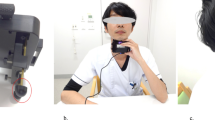Abstract
The electroglottograph (EGG) is a noninvasive, electrical impedance device that was developed for observing vocal fold contact during phonation. After a thorough study of the frequency response characteristics of the EGG, we found that the EGG output can be used to identify maximum laryngeal displacement and the duration of laryngeal movement during swallowing. With a small intranasal pressure transducer placed beneath the velum and the EGG electrodes placed externally on the thyroid cartilage, additional information on the temporal aspects of the swallow can be measured. The EGG has direct clinical application when teaching such techniques as the safe swallow and Mendelsohn maneuver and it is useful as a research technique when using repeated measures designed to study the swallow reflex.
Similar content being viewed by others
References
Perlman AL, Liang X: Frequency response of the Fourcin electroglottograph, and to measurement of temporal aspects of laryngeal movement during swallowing.J. Speech Hear Res (in press).
McConnell F: Analysis of pressure generation and bolus transit during pharyngeal swallowing.Laryngoscope 98:71–78, 1988.
Author information
Authors and Affiliations
Rights and permissions
About this article
Cite this article
Perlman, A.L., Grayhack, J.P. Use of the electroglottograph for measurement of temporal aspects of the swallow: Preliminary observations. Dysphagia 6, 88–93 (1991). https://doi.org/10.1007/BF02493485
Issue Date:
DOI: https://doi.org/10.1007/BF02493485




